Google’s AI information is just wrong.
The meanings and roots of these words
There is a gobo in the photo below. Do you see it? Depending on your background, you are likely to be looking for one thing or another, if you are familiar with the word at all. Most people reading this are looking for a round piece of steel with a pattern cut into it, or they are looking for the textured lighting effect that is produced by that sort of doohickey. The gobo in the picture below is the curved, accordian-style piece of foam rubber that is wrapped around the microphone. This is a picture of a vocal gobo or microphone gobo.
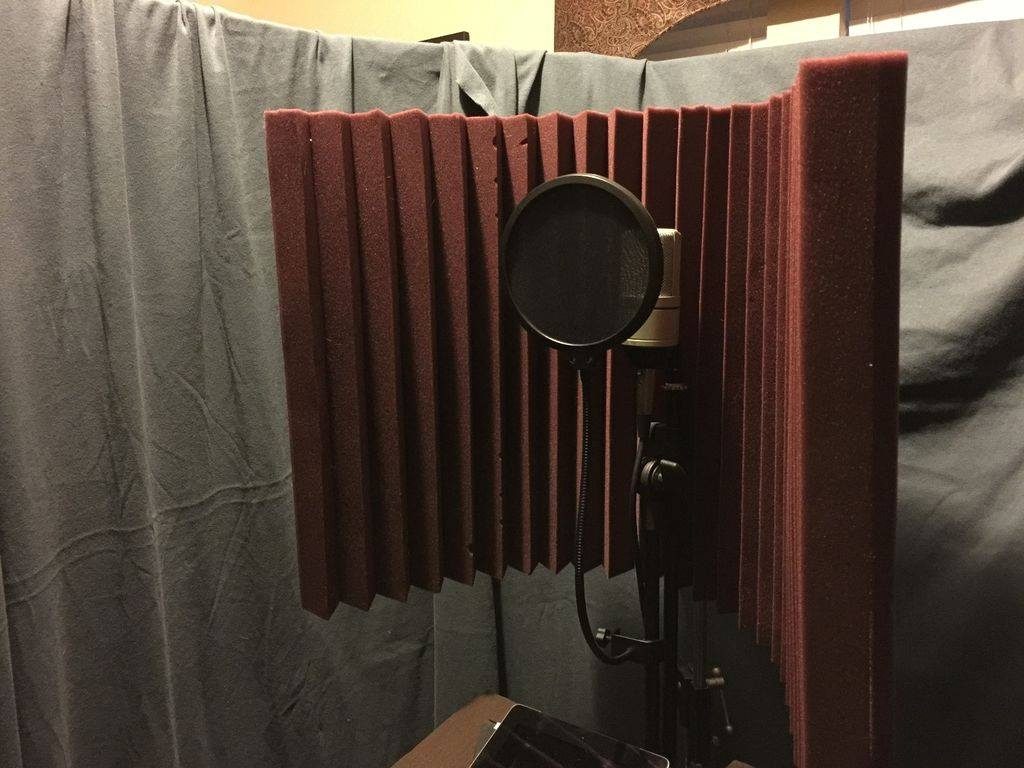
https://www.instructables.com/Vocal-GOBO-Sound-Dampener-Shield-Vocal-Booth-Vocal/
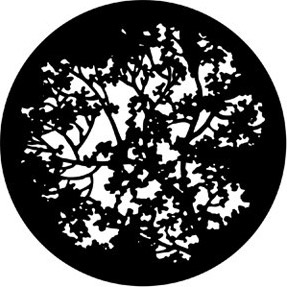
Theatre is a small industry. We have our own jargon and our own small but dear collection of technology. Theatre technology suffers from a serious condition: technical directors and designers – notoriously – write and publish far less than other academics. There is a wonderful book titled Nobody Looks Up: The History of the Counterweight Rigging System: 1500 to 1925 by Rick Boychuk. In it he describes how the history of theatre technology has been at times wildly misrepresented due to its being documented by theatre historians rather than theatrical engineers.
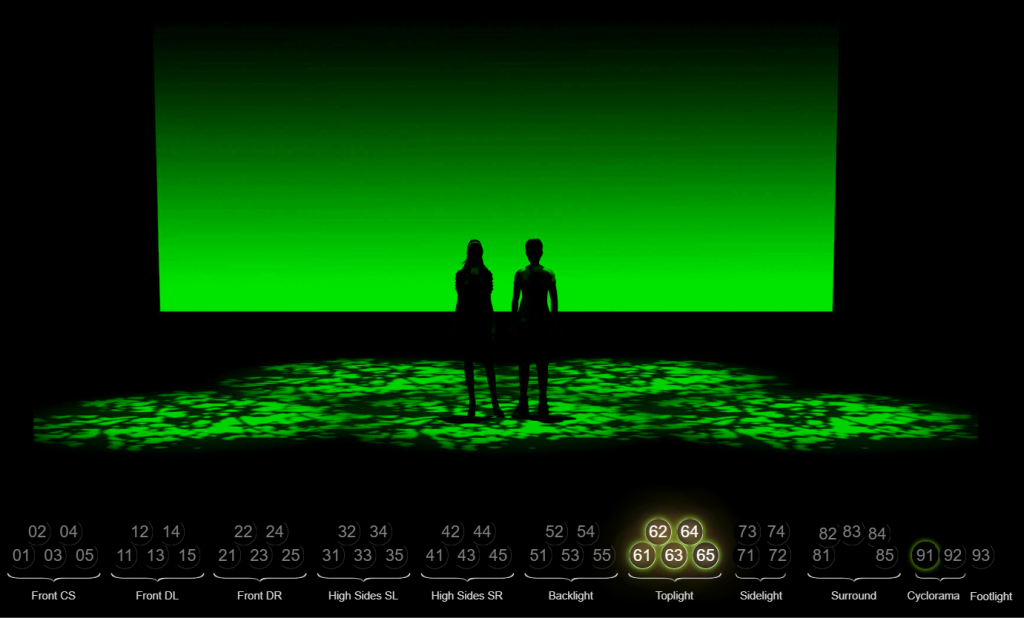
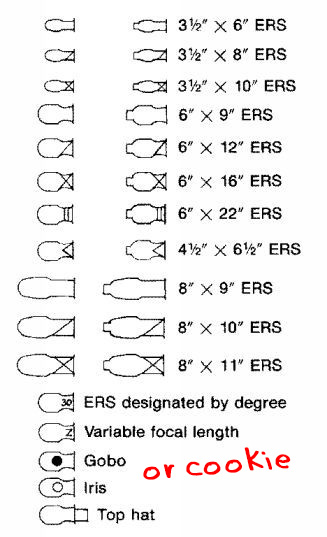
When I first began learning lighting design for performance, I remember seeing a legend for lighting graphics in one of the primary source books. I cannot tell you which one it was now. I am including a USITT lighting legend here for reference. When a gobo is to be used in an ellipsoidal, we mark it on the plot with a large black circle in the body of the instrument. The legend I saw back in perhaps 1986 was marked “gobo or cookie.” At the time, I simply absorbed this as one more thing I was learning on the fly: “cookie” and “gobo” could be used interchangeably. In practice, we only called them gobos. I did not hear the word “cookie” in reference to lighting for a long time.
Back then, the ellipsoidals I worked with were more likely to have an iris in them than a gobo slot. Computer light boards were just coming into use. Theatres had few dimmers and small inventories of instruments. An iris was often the default choice because it made an instrument a little more versatile and more useful to have in stock.
The word “gobo” has been in use in entertainment for about 100 years (though my memory only goes back for some of that). I once looked the word up in an enormous physical dictionary and noticed that in its origin it was a simple piece of wood or other material held up to block light or sound from reaching recording equipment. Online dictionaries still have this etymology. Merriam Webster has the older reference from 1923. Oxford/Lexico has it from 1930. Each is below.
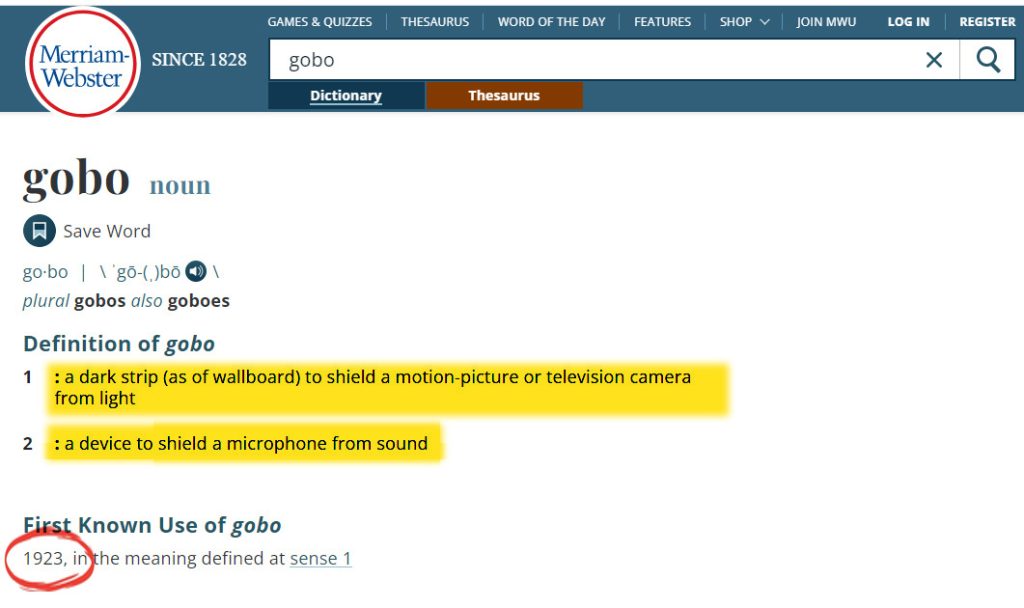
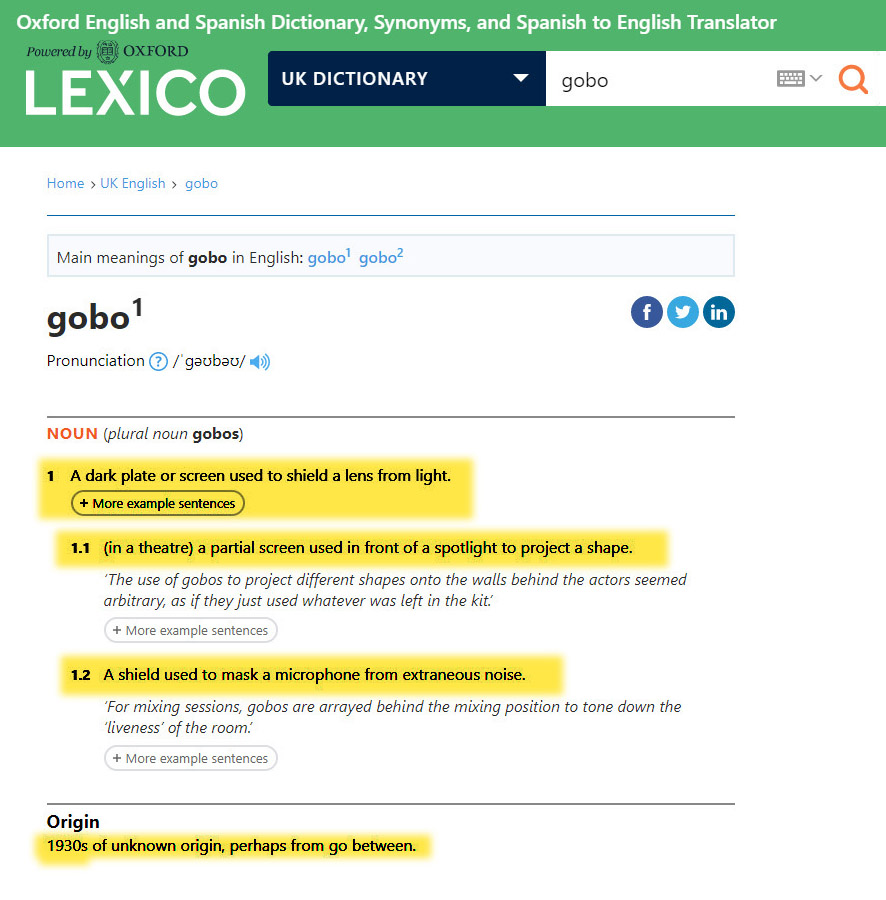
Acronyms: An Assault on a Quaint Old Word
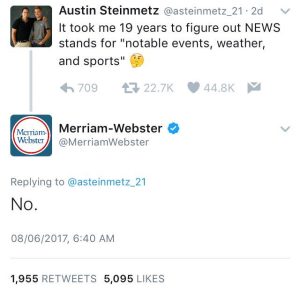
About twelve years ago I had the first ever instance where someone recited the word to me as an acronym. A technician stated it stood for “goes before optics.” That struck me as a wildly high-tech, 21st-century assault on a charming word from the days of vaudeville and silent films. Since then I have heard other somewhat lumbering attempts to make this word an acronym including graphic optical black out, and goes on between optic. The Oxford/Lexico dictionary above suggests a derivation of “goes between” as a possiblity. It’s roots as a low-tech tool in film-camera work and microphone work are evident.
The Amazon listing below is no longer available, but I captured this screenshot in 2019. The word “gobo” is rapidly falling out of use in the audio industry. You will see some of that discussed in a captured conversation thread below. It still appears here and there referring to sound-shields for microphones.

This video is another good demonstration of how the word exists in the audio industry apart from lighting.
Below is a lively thread from a Facebook group called Everything Stage Lighting. It has over 100,000 members. There are some old war-horses from the lighting industry in there and designers from many parts of the world. It yielded some interesting references. I began this thread on sort of a whim in 2019 to see what the general members of the industry thought. I am including the screenshots as well as a text-version.
Some important takeaways from this brief thread:
- Various terms that all easily work out to the shorter term “cookie,’ including
- kukaloris
- cocolorus
- kukes
- Different responders from different parts of the world report variying uses of the term in different eras.
- One of the designers confirmed that gobo was still being used in reference to audio shields in his program, though they were phasing it out.
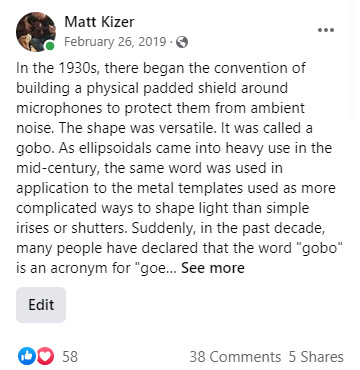
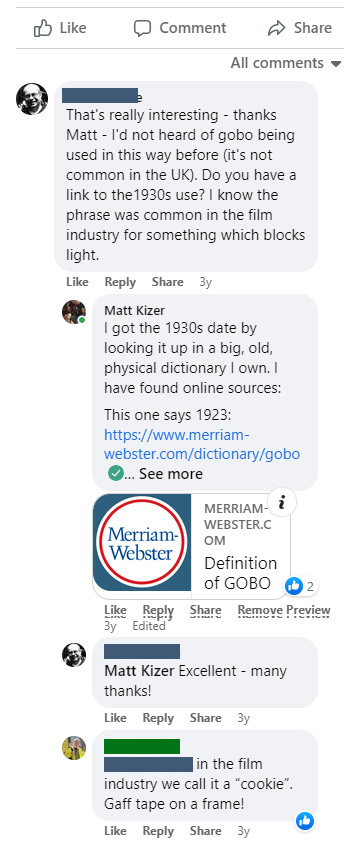
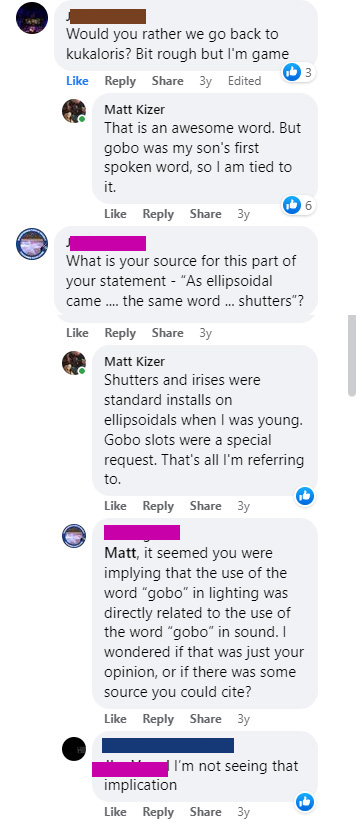
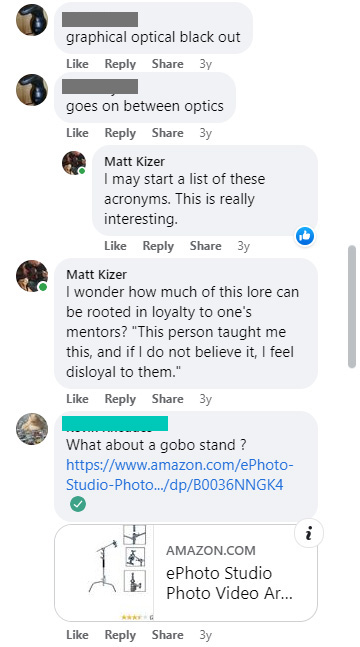

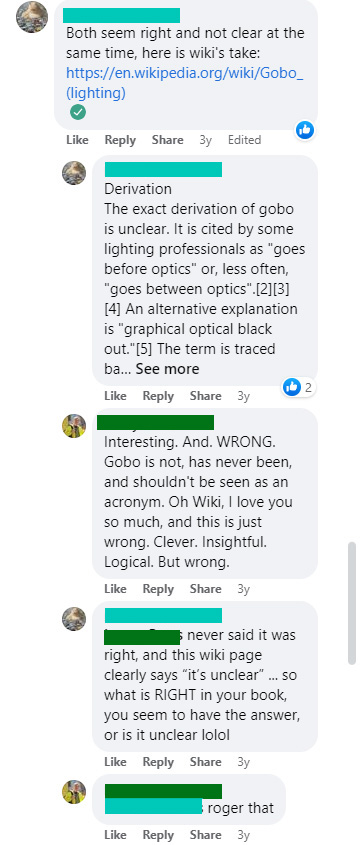
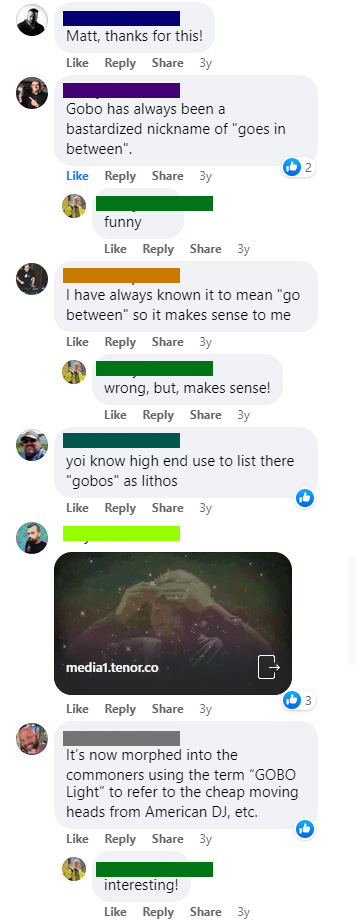
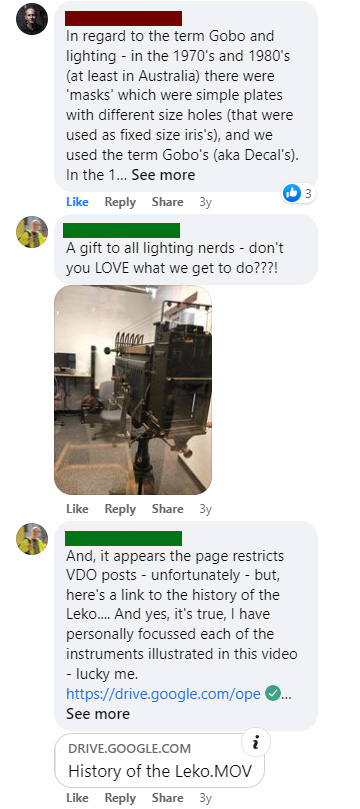
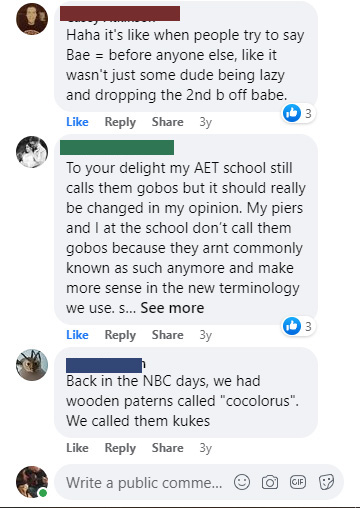
(Text version)
Matt Kizer
In the 1930s, there began the convention of building a physical padded shield around microphones to protect them from ambient noise. The shape was versatile. It was called a gobo. As ellipsoidals came into heavy use in the mid-century, the same word was used in application to the metal templates used as more complicated ways to shape light than simple irises or shutters. Suddenly, in the past decade, many people have declared that the word “gobo” is an acronym for “goes before optics” or similar things. They don’t seem to care that you can still buy microphone gobos on Amazon. They present this invented information as if it were fact, and it is making its way into text books and classrooms.
The reason I fear misinformation like this gaining legs and walking is because it is a microcosm of human knowledge. If this is happening so obviously in my own fields, how much of human knowledge is similarly misconstrued?
Commentor #1
That’s really interesting – thanks Matt – I’d not heard of gobo being used in this way before (it’s not common in the UK). Do you have a link to the1930s use? I know the phrase was common in the film industry for something which blocks light.
Matt Kizer
Author
I got the 1930s date by looking it up in a big, old, physical dictionary I own. I have found online sources:
This one says 1923: https://www.merriam-webster.com/dictionary/gobo
This one says 1930: https://en.oxforddictionaries.com/definition/gobo
Commentor #1
Matt Kizer Excellent – many thanks!
Commentor #2 Commentor #1 in the film industry we call it a “cookie”. Gaff tape on a frame!
Commentor #3
Would you rather we go back to kukaloris? Bit rough but I’m game
Matt Kizer
Author
That is an awesome word. But gobo was my son’s first spoken word, so I am tied to it.
Commentor #4 Matt, it seemed you were implying that the use of the word “gobo” in lighting was directly related to the use of the word “gobo” in sound. I wondered if that was just your opinion, or if there was some source you could cite?
Commentor #5 to Commentor #4 I’m not seeing that implication
Commentor #6
graphical optical black out
Commentor #6
goes on between optic
Matt Kizer
Author
I may start a list of these acronyms. This is really interesting
Matt Kizer
Author
I wonder how much of this lore can be rooted in loyalty to one’s mentors? “This person taught me this, and if I do not believe it, I feel disloyal to them.”
Commentor #7
What about a gobo stand ? https://www.amazon.com/ePhoto-Studio-Photo…/dp/B0036NNGK4
Matt Kizer
Author
I think that’s coming from the world of hum-heads too: https://www.amazon.com/…/dp/B009OAB08S/ref=sr_1_fkmr0_1…
Commentor #2
and, a further niggling connection – century light stand – or Century Light Stand? Curious, as Ed Kook (founder and inventor and pioneer) had manufactured the first shutters and irises (as shared above) in the “ellipsoidal” at the time, known as the Lekolite – aka – the Leko. I am LOVING this thread, BTW.
Commentor #7
Both seem right and not clear at the same time, here is wiki’s take: https://en.wikipedia.org/wiki/Gobo_(lighting)
Commentor #7
Derivation
The exact derivation of gobo is unclear. It is cited by some lighting professionals as “goes before optics” or, less often, “goes between optics”.[2][3][4] An alternative explanation is “graphical optical black out.”[5] The term is traced back to the 1930s, and originated in reference to a screen or sheet of sound-absorbent material for shielding a microphone from sounds coming from a particular direction, with no application to optics. [6] [7] [8] [9] The treatment of the word as an acronym are recent and ignore the original definition in favor of popular invention. There are many online examples of acoustic gobos. [10][11][12]The word most likely is a derivative of “goes between.”
Commentor #2
Interesting. And. WRONG. Gobo is not, has never been, and shouldn’t be seen as an acronym. Oh Wiki, I love you so much, and this is just wrong. Clever. Insightful. Logical. But wrong.
Commentor #7 to Commentor #2 never said it was right, and this wiki page clearly says “it’s unclear” … so what is RIGHT in your book, you seem to have the answer, or is it unclear lolol
Commentor #2 to Commentor #7 roger that
Commentor #8
Matt, thanks for this!
Commentor #9
Gobo has always been a bastardized nickname of “goes in between”
Commentor #2
funny
Commentor #10
I have always known it to mean “go between” so it makes sense to me
Commentor #2
wrong, but, makes sense
Commentor #11
yoi know high end use to list there “gobos” as lithos
Commentor #12
It’s now morphed into the commoners using the term “GOBO Light” to refer to the cheap moving heads from American DJ, etc.
Commentor #2
interesting!
Commentor #13
In regard to the term Gobo and lighting – in the 1970’s and 1980’s (at least in Australia) there were ‘masks’ which were simple plates with different size holes (that were used as fixed size iris’s), and we used the term Gobo’s (aka Decal’s).
In the 1980’s I used to sell Selecon lighting (a New Zealand manufacturer) and was told that Gobo stood for Goes Between (meaning goes between Lamp and optics). The term Decal (perhaps spelt Deckle) was also in use and it was like a silhouette. I’m fairly sure that these terms are still in use today.
My point is that these terms (for lighting) are not something that happened in the last Decade, I’m fairly sure they have been used at least for the last 50 years.
Commentor #2
A gift to all lighting nerds – don’t you LOVE what we get to do???!
Commentor #2
And, it appears the page restricts VDO posts – unfortunately – but, here’s a link to the history of the Leko…. And yes, it’s true, I have personally focussed each of the instruments illustrated in this video – lucky me.
https://drive.google.com/open…
Commentor #14
Haha it’s like when people try to say Bae = before anyone else, like it wasn’t just some dude being lazy and dropping the 2nd b off babe.
Commentor #15
To your delight my AET school still calls them gobos but it should really be changed in my opinion. My piers and I at the school don’t call them gobos because they arnt commonly known as such anymore and make more sense in the new terminology we use. so Gobos for sound = iso Panels, and Gobos for lights = gobos
Commentor #16
Back in the NBC days, we had wooden paterns called “cocolorus”. We called them kukes
Cookies and Cucoloris
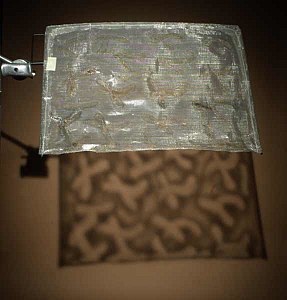
Author: Henry Nelson
Own work
00:01, 29 May 2017
License by CC BY-SA 4.0
Cucoloris
https://www.definitions.net/definition/cucoloris
In lighting for film, theatre and still photography, a cuculoris is a device for casting shadows or silhouettes to produce patterned illumination. The word is sometimes shortened to cookie or coo-koo. The cookie is used to create a more natural look by breaking up the light from a man made source. It can be used to simulate movement by passing shadows or light coming through a leafy canopy. Generally, cookies fall into three groups: hard cookies, made from thin plywood or heavy poster board with random shapes cut out of the body; soft cookies, made from plastic impregnated screen, also with random shapes cut or burned out; and brancholorises or dingles, which are simply tree limbs or other available things that can be placed between the light and the subject. Many “old-school” grips would say that any unnatural pattern used to create a shadow is a cookie. Cucolorises are sometimes thought of as a subset of the gobo category. A gobo is either a metal or a glass device, used inside a lighting instrument, used to create patterns, shadows, logos or silhouettes.
Both B&H Video and Modern Studio Equipment include these terms in their product categories:
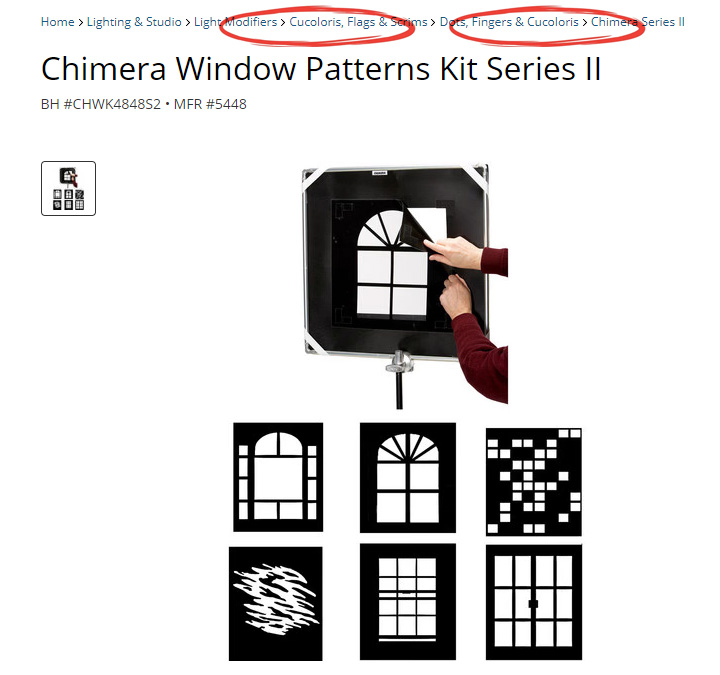
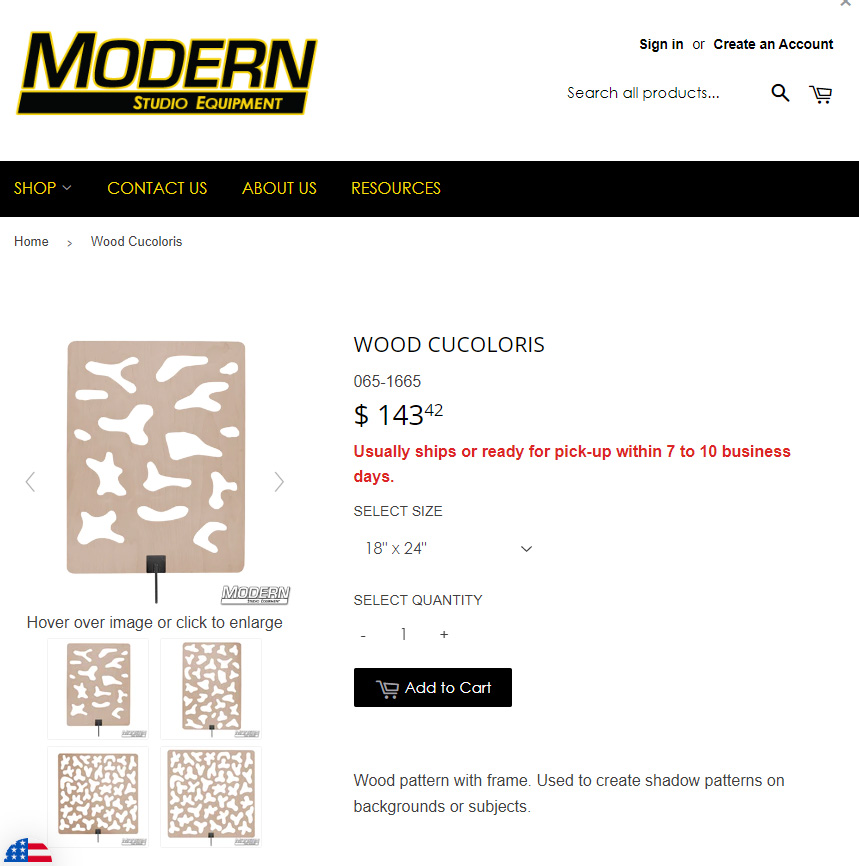
And finally, I stumbled on this picture cited as crew working on the film American Treasure. An enormous cookie like this has the advantage that it can cast a sharp shadow without being placed strategically inside of a lighting instrument. This works well for camera-work. It is easy to leave the crew and their pole-arm out of the shot. Whereas film can get away with large and complicated rigging on the set, theatre usually requires its instrumentation to be compact and recessed. I think of that technician on the right as a professional gobo holder.
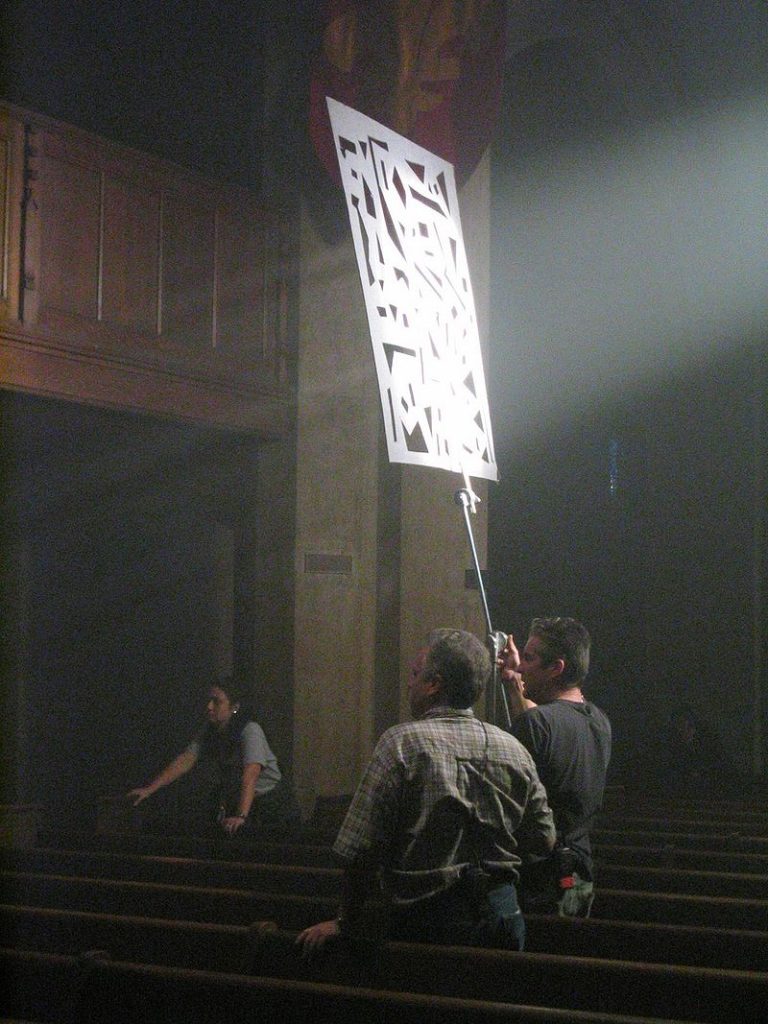
Sean Devine, CC BY-SA 3.0 https://creativecommons.org/licenses/by-sa/3.0, via Wikimedia Commons
